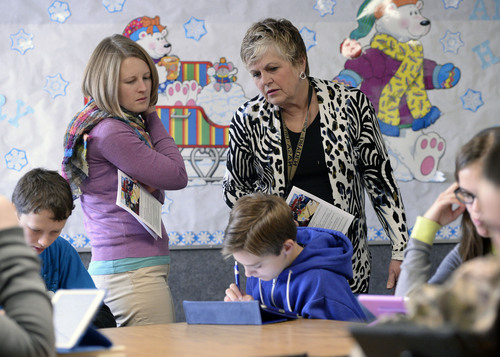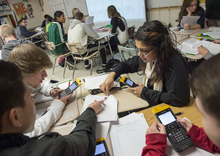This is an archived article that was published on sltrib.com in 2014, and information in the article may be outdated. It is provided only for personal research purposes and may not be reprinted.
A massive push to expand technology in Utah schools cleared its first serious hurdle Wednesday — despite persistent and unanswered questions about how sponsors plan to pay for the $200 million price tag.
"I would like to not get caught up in numbers," said Rep. Francis Gibson, R-Mapleton, who, along with House Speaker Becky Lockhart, R-Provo, is pushing the major technology upgrade.
Instead, Gibson challenged his colleagues to think about the direction they want to take Utah education, assuring them that the money will follow the vision.
"This is an opportunity for us to do something different. It's a big, bold step I'm asking you to support," Gibson said. "I'm asking you to look forward 10 years from now. Where will we be? Where will we go? We have to take a first step somewhere, and I'm asking you to do that."
The House Education Committee voted 13-1 to approve Gibson's HB131 and move it to the full House. But, as Rep. Brad Last, R-Hurricane and co-chairman of the education budget committee, acknowledged, the devil will be in the budget details.
Gov. Gary Herbert, Senate Republican leaders and state education officials already have expressed concern about how to pay for the ambitious plan.
Herbert reiterated this week that his top priorities remain paying for more than 10,000 new students expected to enter Utah schools next year and increasing the state's last-in-the-nation per-pupil spending, which is in line with the priorities from the Utah Board of Education.
Rep. Patrice Arent, D-Millcreek, said she supports technology, but wants to ensure it's not coming at the expense of other classroom needs. "I just want to make sure we're protecting our teachers, protecting our classrooms and not taking money out of their pockets."
Gibson assured it was not his intent to fund digital education at the expense of other needs, but noted that his proposal to expand technology training for teachers alone would mark a significant boost in teacher pay.
Thomas Greaves, of Project RED, an education-technology think tank funded by several large tech companies, said that if Utah does it right, statewide test scores, learning rates, attendance and parental involvement will rise and disciplinary incidents and dropout rates will fall.
"If this bill is properly implemented," he said, "I am very, very sure, highly confident, that the outcomes you are looking for will be achieved."
Mark Towner, a science teacher at Granite Park Junior High, said he has been using technology in his classrooms and believes it makes him a more effective educator. Towner said he has seen his students performing between 10 percent and 15 percent better than those who don't have the digital devices.
Rep. Marie Poulson, D-Cottonwood Heights, asked if the bill is designed to benefit specific technology vendors.
"Just in this audience," Poulson said, "I see a whole bunch of them who are salivating, wetting their lips at [the idea of] getting this,."
Gibson said it would be up to the state office and districts to decide which programs best meet their schools' needs.
"There's not any one particular vendor that wins here," he said. "It's based on what the school districts decide to choose."
Under the bill, the Utah Office of Education would create an advisory panel to review submissions from education software and hardware firms. School districts could then apply for grants from the state to buy and implement those programs that pass muster.
The bill also includes $50 million to upgrade the existing wireless network in schools and requires at least 40 hours of teacher training time, Gibson said, so instructors are equipped to use the new technological tools.
Twitter: @RobertGehrke















